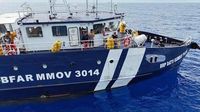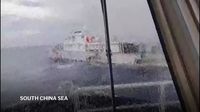In a dramatic escalation of maritime tensions in the South China Sea, ships from China and the Philippines collided near the disputed Scarborough Shoal on September 16, 2025, resulting in significant damage to a Filipino fishing vessel and injuries to at least one crew member. The incident, which unfolded over nearly half an hour, has reignited international debate over territorial claims and the use of force in one of the world’s most contested waterways.
According to the Philippine Coast Guard, two Chinese coast guard ships targeted the Filipino fisheries vessel BRP Datu Gumbay Piang with powerful water cannons for almost 30 minutes, causing extensive damage to the captain’s cabin and the bridge. Commodore Jay Tarriela, a spokesperson for the Philippine Coast Guard, described the event as “aggressive action” that lasted for about 29 minutes, resulting in “significant damage, including shattered glass from the aft window of the bridge.” One crew member was reportedly injured by the flying glass, with electrical outlets and five outdoor air-conditioning units also damaged due to water ingress, as reported by The Associated Press.
The confrontation did not happen in isolation. The Philippine Coast Guard stated that their vessels were in the area to resupply more than 35 Filipino fishing boats with fuel, water, ice, and other essentials. The BRP Datu Gumbay Piang, in particular, was delivering food to fishermen operating near the shoal, which sits within the Philippines’ United Nations-defined exclusive economic zone. The area, however, is fiercely claimed by China as part of its historical maritime territory, despite a 2016 ruling from the Permanent Court of Arbitration in The Hague that invalidated Beijing’s expansive claims. China has consistently rejected the ruling.
As the two sides traded accusations, the Chinese Coast Guard offered a starkly different narrative. Gan Yu, a spokesperson for the China Coast Guard, alleged that the Philippine ship had “disregarded solemn warnings from the Chinese side and deliberately rammed a Chinese coast guard vessel.” Gan Yu confirmed that water cannons had been used after the arrival of more than 10 Philippine government ships, which, according to China, had entered the waters around the shoal illegally. The Chinese Coast Guard insisted it had “lawfully implemented control measures against the Philippine ships,” including issuing verbal warnings and imposing route restrictions.
Both sides released video footage showing the collision between the Chinese and Philippine vessels, underscoring the high-stakes brinkmanship that has come to characterize encounters in the region. The Philippine Maritime Council dismissed China’s version of events, telling Reuters, “There is no truth to China’s claim that it had taken control measures against the Philippine ships,” labeling it “another case of Chinese disinformation and propaganda.”
The incident occurred just six days after China announced it would designate part of the 8,650-acre Scarborough Shoal—known as Huangyan Island in China and Bajo de Masinloc in the Philippines—as a national nature reserve. The move was swiftly condemned by the Philippines and its allies, who argued that the nature reserve designation was less about environmental protection and more about solidifying China’s territorial control. The Philippine Department of Foreign Affairs responded by launching a formal diplomatic protest, calling China’s action “illegitimate and unlawful.”
International reaction was swift and pointed. U.S. Secretary of State Marco Rubio took to X (formerly Twitter), calling China’s plans for the Scarborough Reef “yet another coercive move to advance sweeping territorial and maritime claims in the South China Sea at the expense of its neighbors.” The United Kingdom, Australia, and Canada also voiced concern, with the Canadian embassy in the Philippines suggesting that China’s “attempts to use environmental protection” were a cover for asserting control over the disputed shoal.
The Scarborough Shoal, a triangular set of rocks and reefs, is located about 240 kilometers (150 miles) west of Luzon, the Philippines’ main island. It has long been a flashpoint in the broader South China Sea dispute, with both countries regularly accusing each other of provocation and illegal activity. The area is not only rich in marine resources but also holds strategic military significance, making it a focal point for both regional and global powers.
China’s claims in the South China Sea extend over almost the entire waterway, overlapping with the exclusive economic zones of several Southeast Asian nations, including Vietnam, Malaysia, Brunei, and the Philippines. Despite the 2016 arbitration ruling, Beijing has continued to build artificial islands, deploy maritime militia, and enforce what it calls its historical rights. The latest incident at Scarborough Shoal follows a pattern of increasingly assertive Chinese actions, often met with diplomatic protests and military drills by its neighbors and their allies.
Notably, last week saw joint military exercises in the South China Sea involving the Philippines, the United States, and Japan. In response, China’s military issued a warning, stating, “Any attempt to stir up trouble or disrupt the situation will not succeed,” according to the Chinese military’s Southern Theater Command. The timing of the Scarborough Shoal incident, so soon after these drills and China’s nature reserve announcement, has fueled speculation about broader strategic maneuvering by all parties involved.
For Filipino fishermen, the latest clash is yet another reminder of the daily risks they face while pursuing their livelihood in contested waters. The Philippine Coast Guard reported that a Chinese navy warship broadcast a radio notice “announcing live-fire exercises” at the shoal, causing panic among those at sea. Such psychological tactics, combined with physical confrontations, have contributed to a climate of fear and uncertainty in communities dependent on the South China Sea for their survival.
As tensions remain high, the international community continues to watch developments closely. The United States, the United Kingdom, Australia, and Canada have all reiterated their support for the Philippines’ position and called for the peaceful resolution of disputes in accordance with international law. Meanwhile, Beijing shows no sign of backing down, insisting that its actions are both legal and justified.
With both countries entrenched in their positions, and with global powers weighing in, the events of September 16 serve as a stark illustration of the volatility and complexity of the South China Sea dispute. For those caught in the middle—especially the fishermen whose livelihoods depend on these waters—the stakes could not be higher.






